Abstract
Rats convalescing from a recent infection with Listeria monocytogenes generate T cells which can protect recipient rats against a challenge infection with that organism. Using monoclonal antibodies that react with some but not all rat peripheral T cells, the T-cell mediators of acquired resistance to infection (TCRI) were isolated by panning and characterized by using a fluorescence-activated cell sorter. Many L. monocytogenes-immune TCRI were relatively large cells as judged by their light-scattering properties. That finding accords with previously reported cytokinetic data and velocity sedimentation analyses which revealed that the majority of L. monocytogenes-immune TCRI are lymphoblasts. In the current investigation, the surface antigenic profile of these mediator T cells was revealed as W3/25+ OX8+ OX4+ RT6.1-. That phenotype is identical to that of L. monocytogenes-induced prekiller cells which are formed as part of the animal's cell-mediated response to infection. Like prekiller cells and their differentiated counterparts, L. monocytogenes-immune TCRI adhere preferentially to monolayers of syngeneic fibroblasts. The results indicate that L. monocytogenes-immune TCRI belong to a minor subset of peripheral T cells which also contains T cells that have the cytotoxic potential by which L. monocytogenes-induced prekiller cells have been defined.
Full text
PDF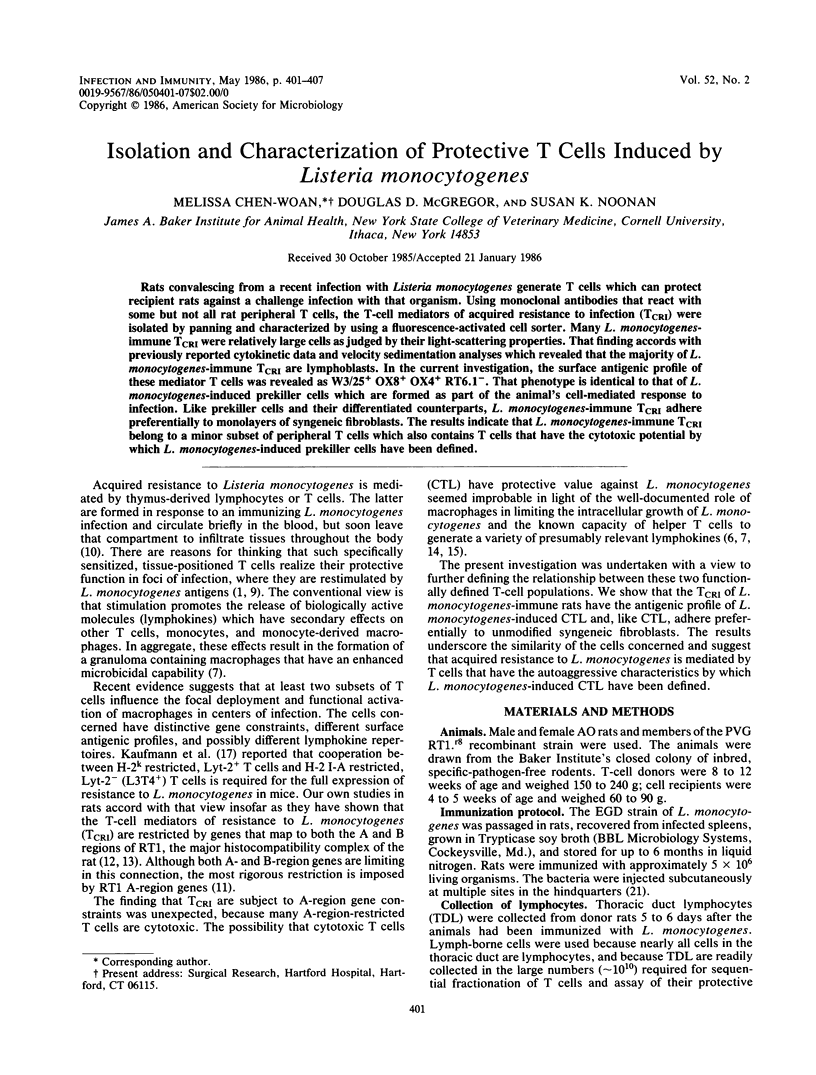
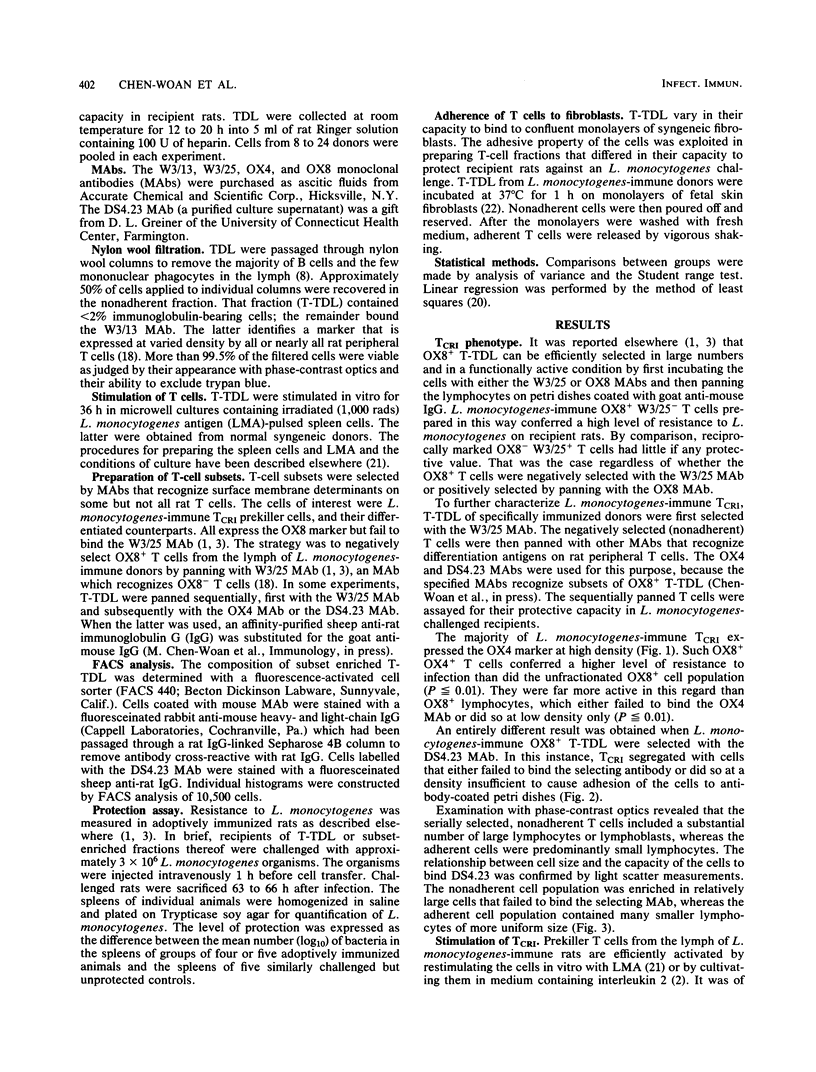
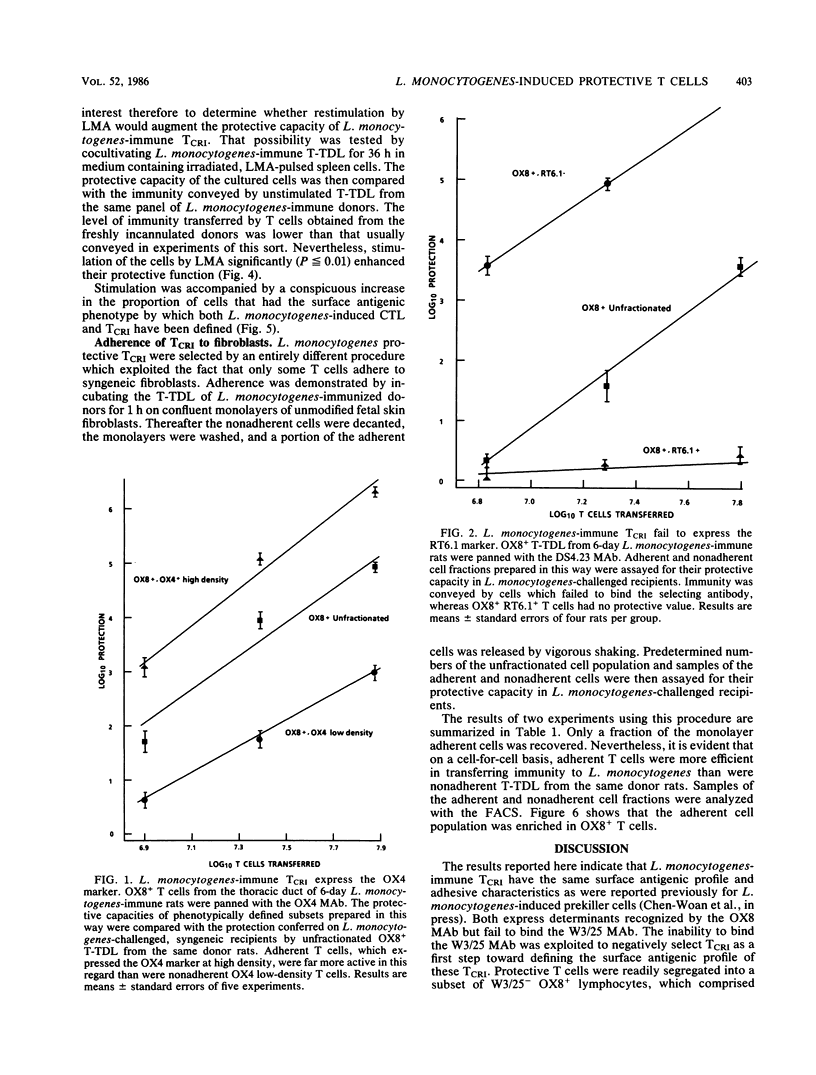
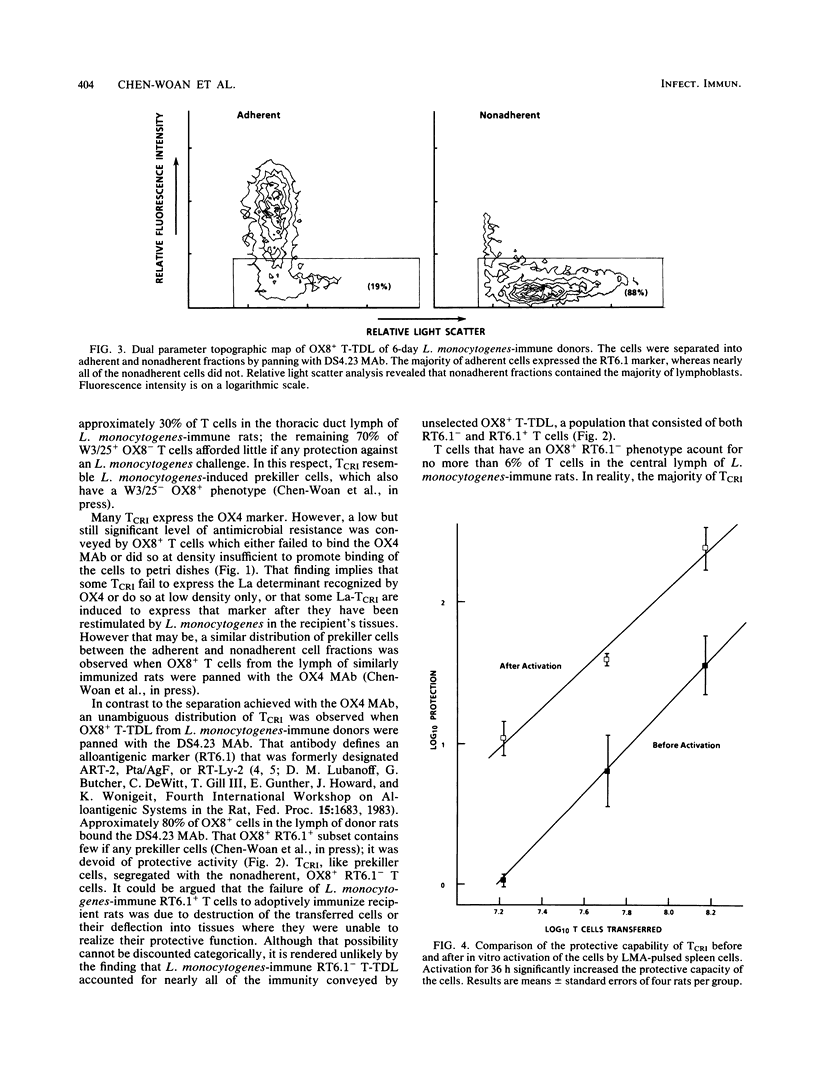
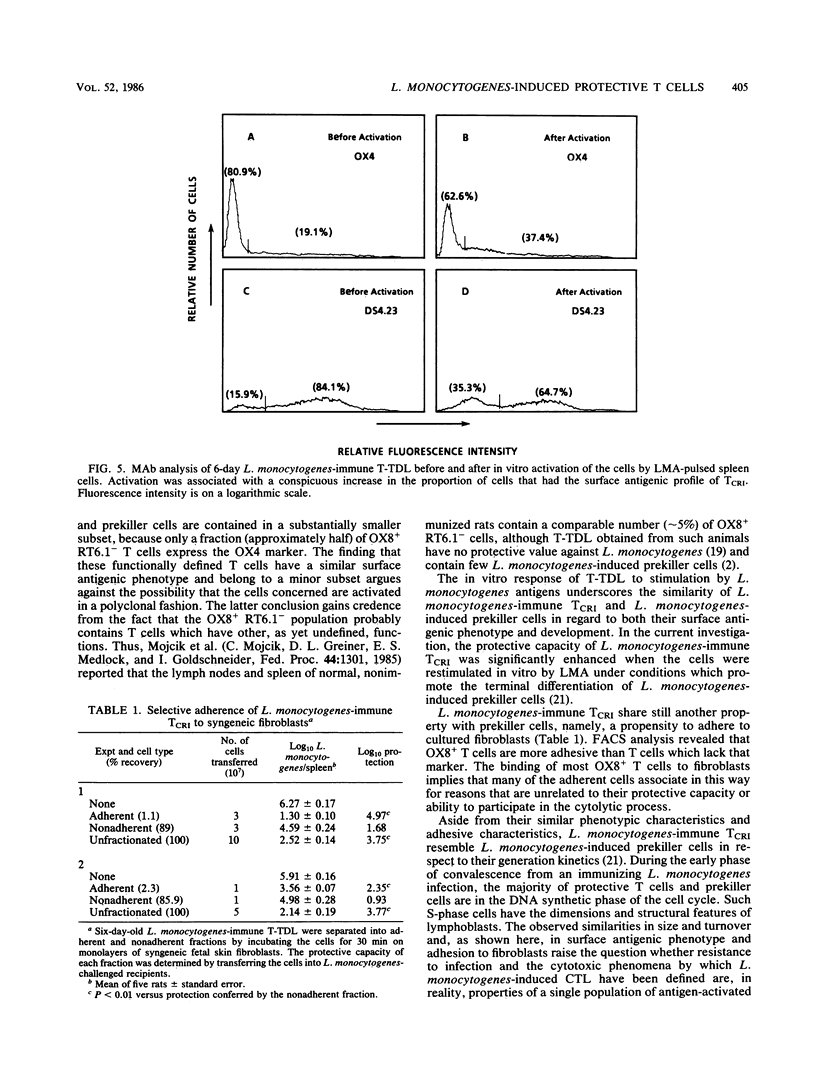
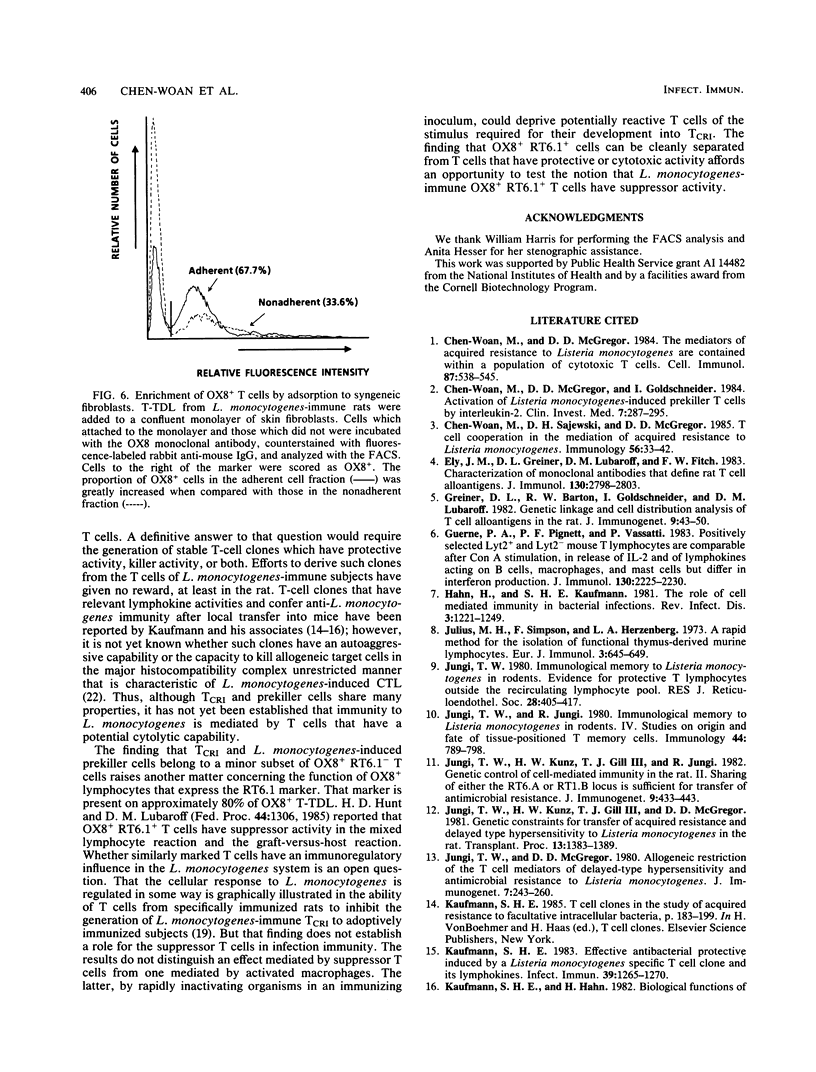
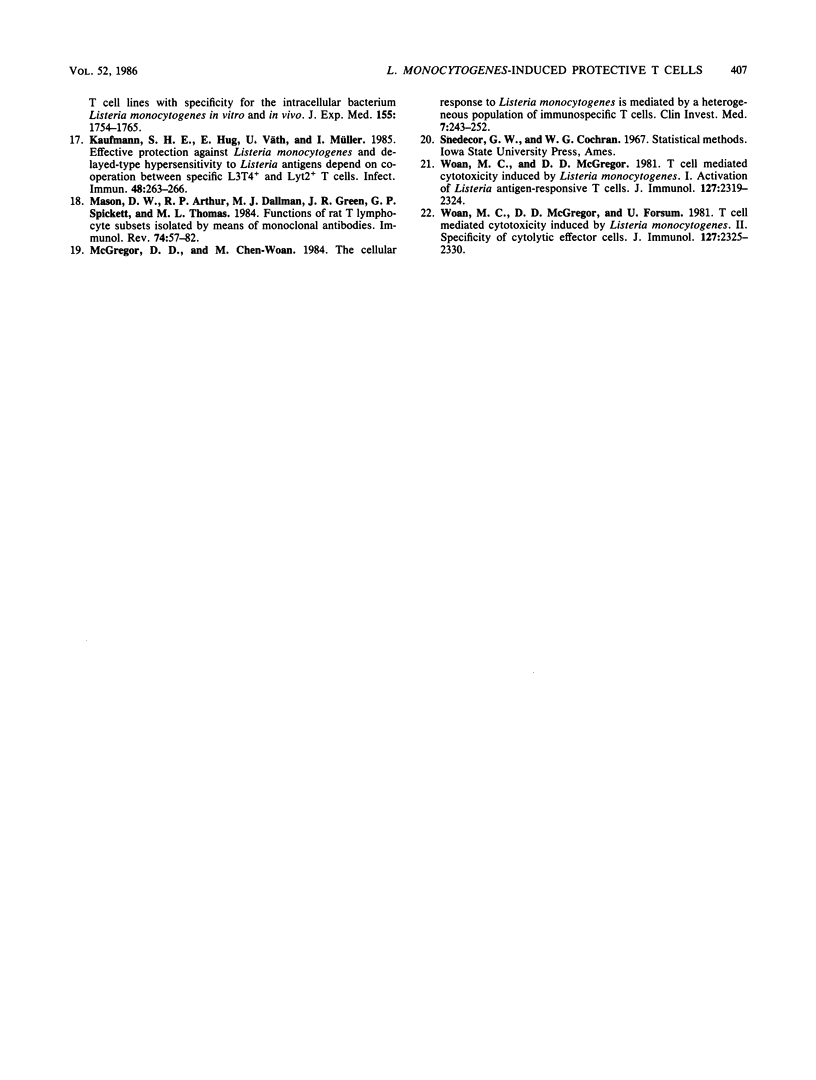
Selected References
These references are in PubMed. This may not be the complete list of references from this article.
- Chen-Woan M., McGregor D. D., Goldschneider I. Activation of Listeria monocytogenes-induced prekiller T cells by interleukin-2. Clin Invest Med. 1984;7(4):287–295. [PubMed] [Google Scholar]
- Chen-Woan M., McGregor D. D. The mediators of acquired resistance to Listeria monocytogenes are contained within a population of cytotoxic T cells. Cell Immunol. 1984 Sep;87(2):538–545. doi: 10.1016/0008-8749(84)90022-4. [DOI] [PubMed] [Google Scholar]
- Chen-Woan M., Sajewski D. H., McGregor D. D. T-cell co-operation in the mediation of acquired resistance to Listeria monocytogenes. Immunology. 1985 Sep;56(1):33–42. [PMC free article] [PubMed] [Google Scholar]
- Ely J. M., Greiner D. L., Lubaroff D. M., Fitch F. W. Characterization of monoclonal antibodies that define rat T cell alloantigens. J Immunol. 1983 Jun;130(6):2798–2803. [PubMed] [Google Scholar]
- Greiner D. L., Barton R. W., Goldschneider I., Lubaroff D. M. Genetic linkage and cell distribution analysis of T cell alloantigens in the rat. J Immunogenet. 1982 Feb;9(1):43–50. doi: 10.1111/j.1744-313x.1982.tb00781.x. [DOI] [PubMed] [Google Scholar]
- Guerne P. A., Piguet P. F., Vassalli P. Positively selected Lyt-2+ and Lyt-2- mouse T lymphocytes are comparable, after Con A stimulation, in release of IL 2 and of lymphokines acting on B cells, macrophages, and mast cells, but differ in interferon production. J Immunol. 1983 May;130(5):2225–2230. [PubMed] [Google Scholar]
- Hahn H., Kaufmann S. H. The role of cell-mediated immunity in bacterial infections. Rev Infect Dis. 1981 Nov-Dec;3(6):1221–1250. doi: 10.1093/clinids/3.6.1221. [DOI] [PubMed] [Google Scholar]
- Julius M. H., Simpson E., Herzenberg L. A. A rapid method for the isolation of functional thymus-derived murine lymphocytes. Eur J Immunol. 1973 Oct;3(10):645–649. doi: 10.1002/eji.1830031011. [DOI] [PubMed] [Google Scholar]
- Jungi T. W. Immunological memory to Listeria monocytogenes in rodents: evidence for protective T lymphocytes outside the recirculating lymphocyte pool. J Reticuloendothel Soc. 1980 Oct;28(4):405–417. [PubMed] [Google Scholar]
- Jungi T. W., Jungi R. Immunological memory to Listeria monocytogenes in rodents. IV. Studies on origin and fate of tissue-positioned T memory cells. Immunology. 1981 Dec;44(4):789–798. [PMC free article] [PubMed] [Google Scholar]
- Jungi T. W., Kunz H. W., Gill T. J., 3rd, Jungi R. Genetic control of cell-mediated immunity in the rat. II. Sharing of either the RT1.A or RT1.B locus is sufficient for transfer of antimicrobial resistance. J Immunogenet. 1982 Dec;9(6):433–443. doi: 10.1111/j.1744-313x.1982.tb01005.x. [DOI] [PubMed] [Google Scholar]
- Jungi T. W., Kunz H. W., Gill T. J., 3rd, McGregor D. D. Genetic constraints for transfer of acquired resistance and delayed-type hypersensitivity to Listeria monocytogenes in the rat. Transplant Proc. 1981 Jun;13(2):1383–1389. [PubMed] [Google Scholar]
- Jungi T. W., McGregor D. D. Allogeneic restriction in the rat: genetic basis of restriction of the T cell mediators of delayed-type hypersensitivity and antimicrobial resistance to Listeria monocytogenes. J Immunogenet. 1980 Jun;7(3):243–260. doi: 10.1111/j.1744-313x.1980.tb00934.x. [DOI] [PubMed] [Google Scholar]
- Kaufmann S. H. Effective antibacterial protection induced by a Listeria monocytogenes-specific T cell clone and its lymphokines. Infect Immun. 1983 Mar;39(3):1265–1270. doi: 10.1128/iai.39.3.1265-1270.1983. [DOI] [PMC free article] [PubMed] [Google Scholar]
- Kaufmann S. H., Hug E., Väth U., Müller I. Effective protection against Listeria monocytogenes and delayed-type hypersensitivity to listerial antigens depend on cooperation between specific L3T4+ and Lyt 2+ T cells. Infect Immun. 1985 Apr;48(1):263–266. doi: 10.1128/iai.48.1.263-266.1985. [DOI] [PMC free article] [PubMed] [Google Scholar]
- Mason D. W., Arthur R. P., Dallman M. J., Green J. R., Spickett G. P., Thomas M. L. Functions of rat T-lymphocyte subsets isolated by means of monoclonal antibodies. Immunol Rev. 1983;74:57–82. doi: 10.1111/j.1600-065x.1983.tb01084.x. [DOI] [PubMed] [Google Scholar]
- McGregor D. D., Chen-Woan M. The cellular response to Listeria monocytogenes is mediated by a heterogeneous population of immunospecific T cells. Clin Invest Med. 1984;7(4):243–252. [PubMed] [Google Scholar]
- Woan M. C., McGregor D. D., Forsum U. T cell-mediated cytotoxicity induced by Listeria monocytogenes. II. Specificity of cytolytic effector cells. J Immunol. 1981 Dec;127(6):2325–2330. [PubMed] [Google Scholar]
- Woan M. C., McGregor D. D. T cell-mediated cytotoxicity induced by Listeria monocytogenes. I. Activation of Listeria antigen-responsive T cells. J Immunol. 1981 Dec;127(6):2319–2324. [PubMed] [Google Scholar]


